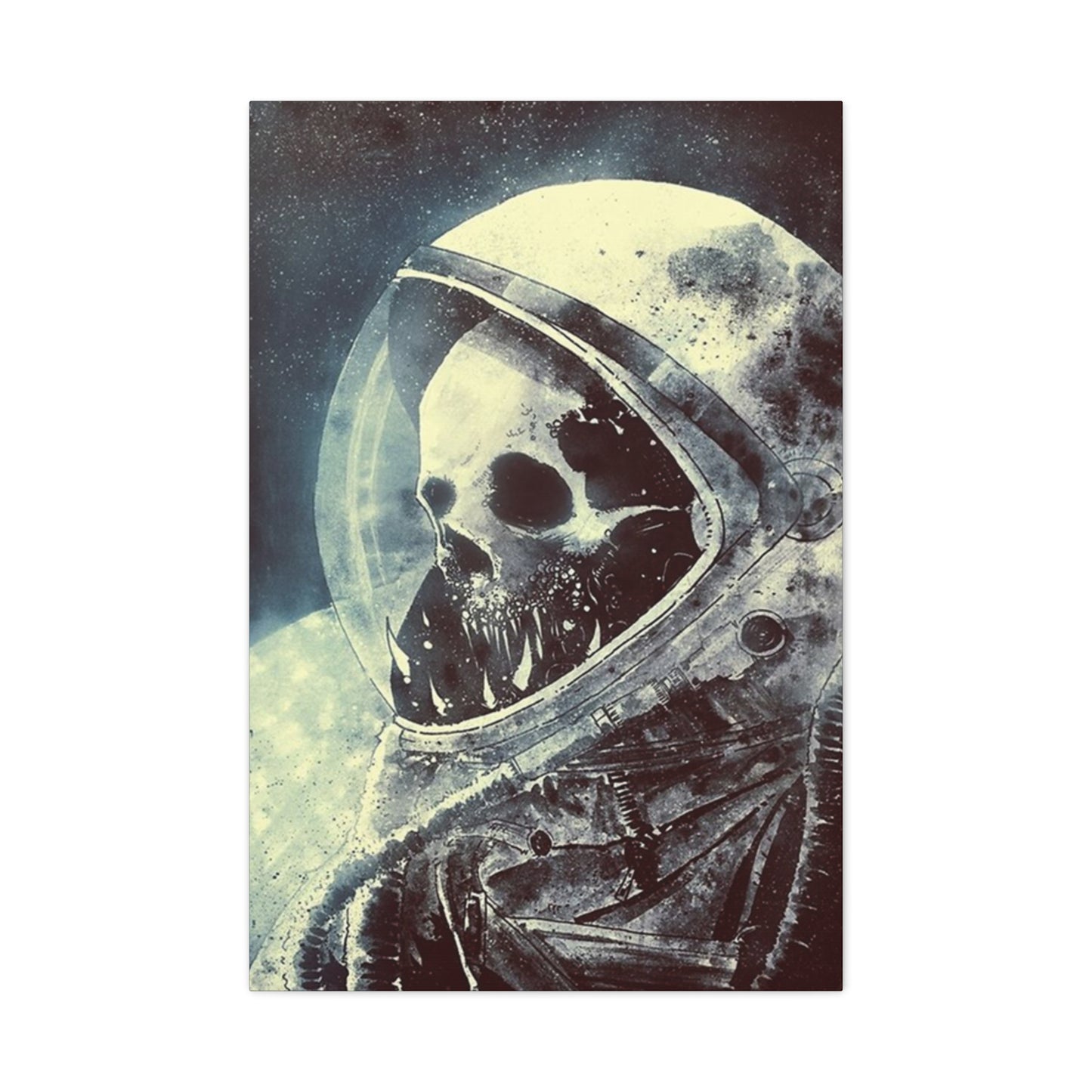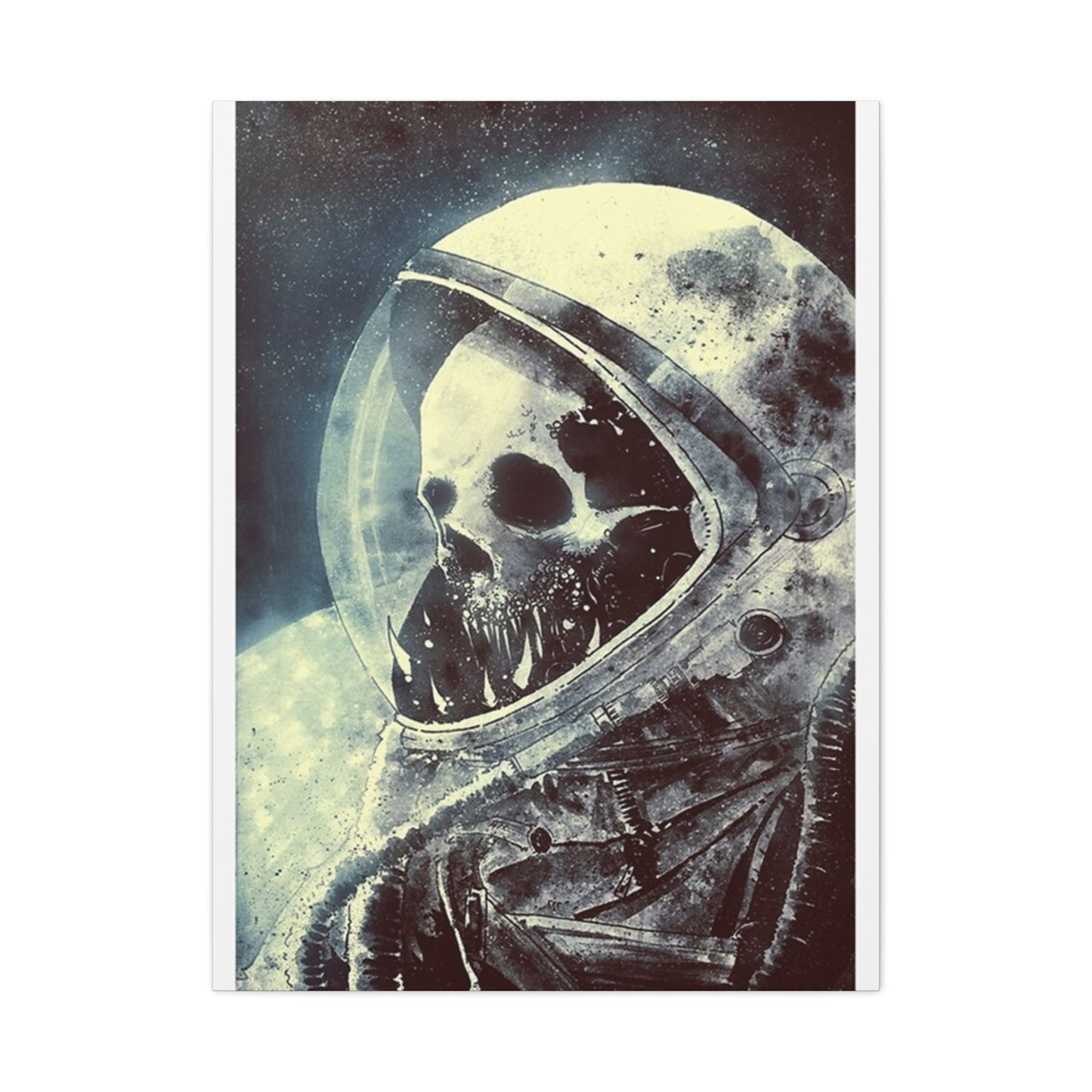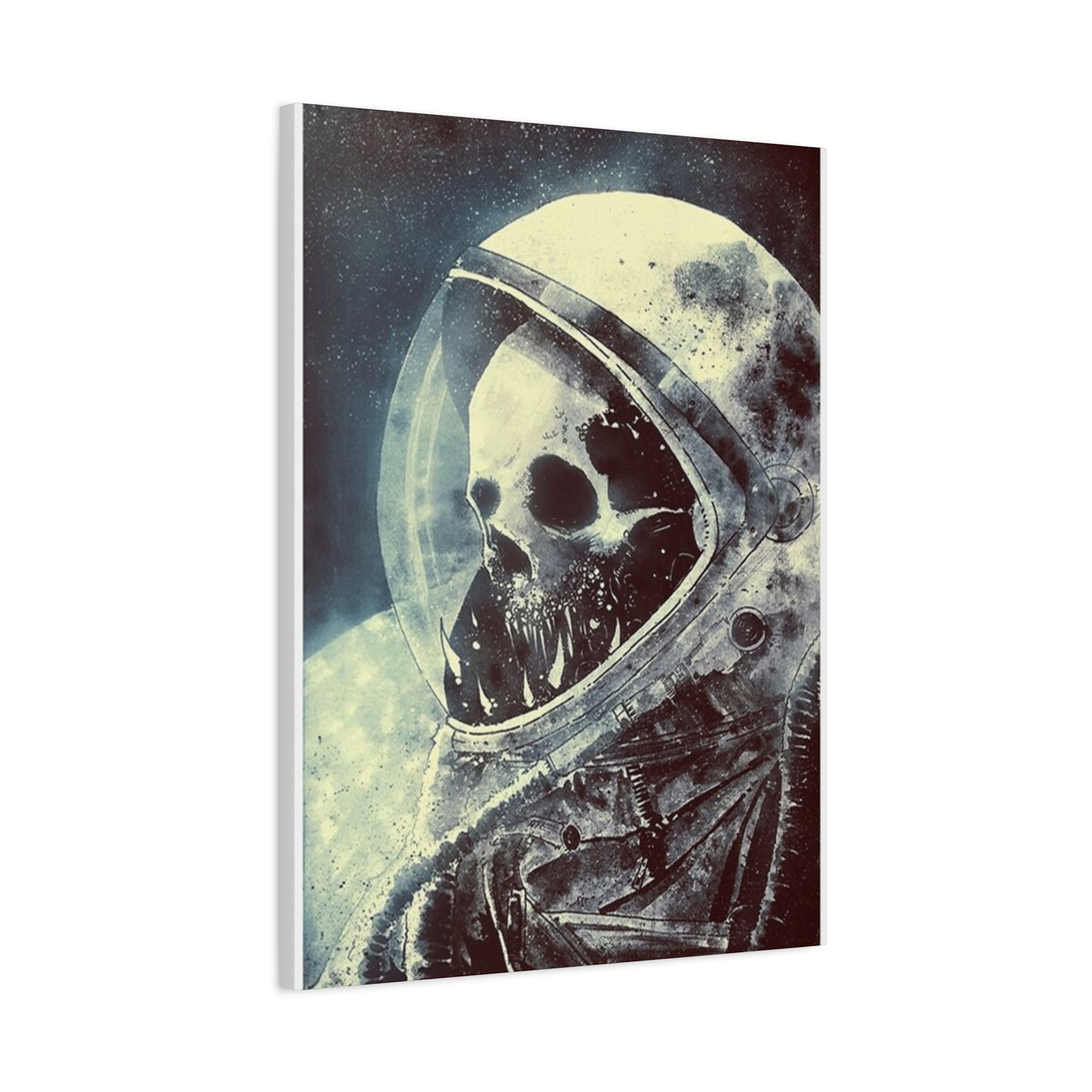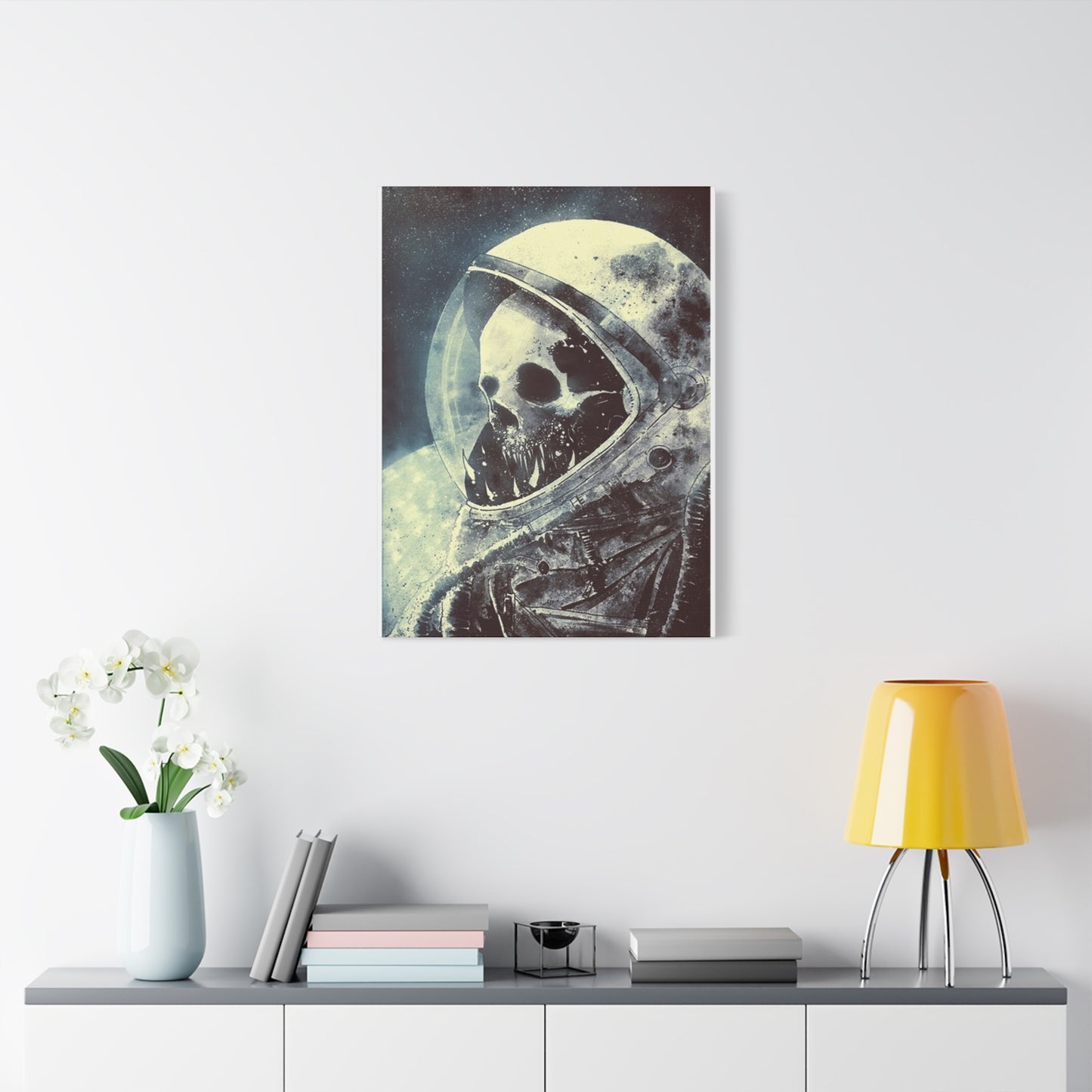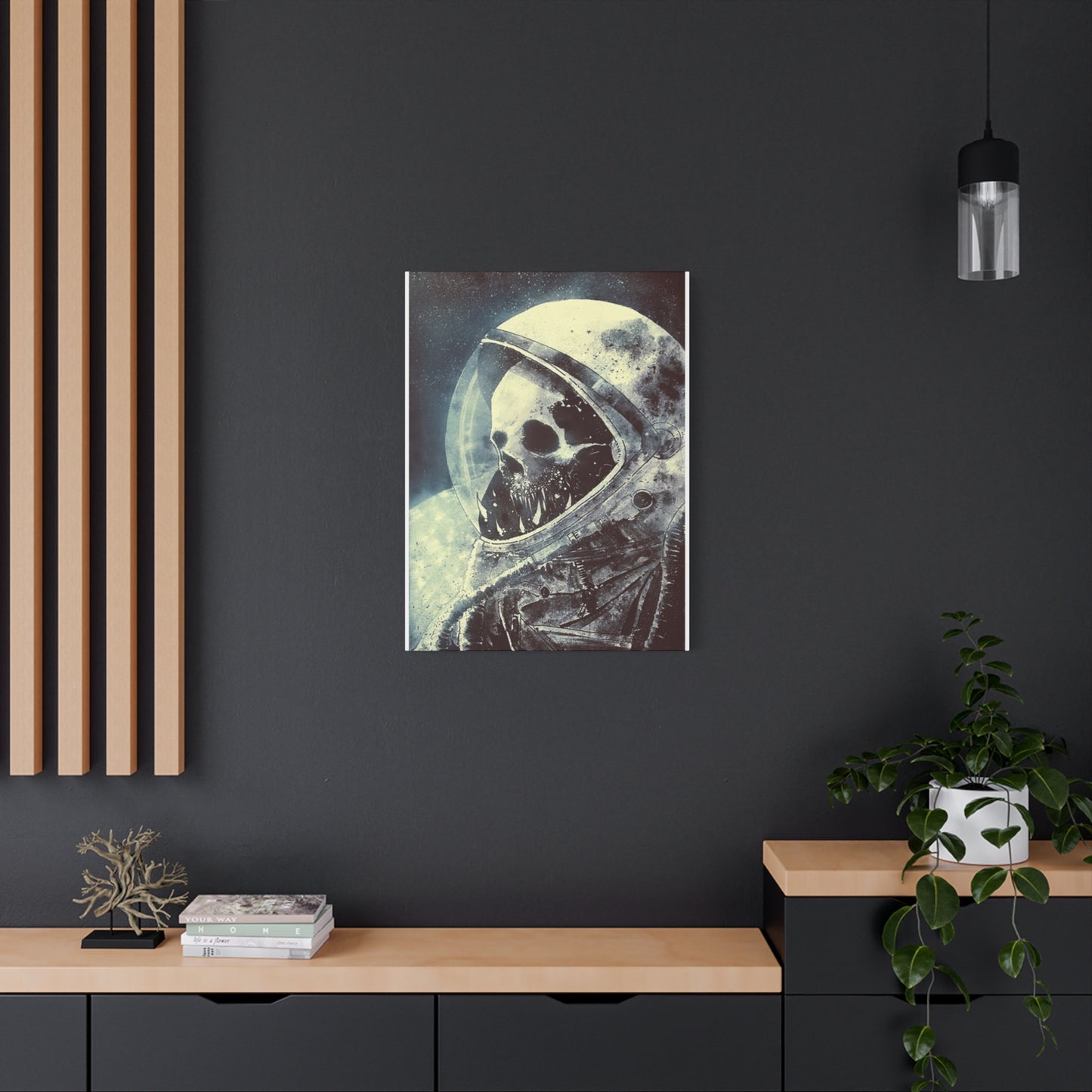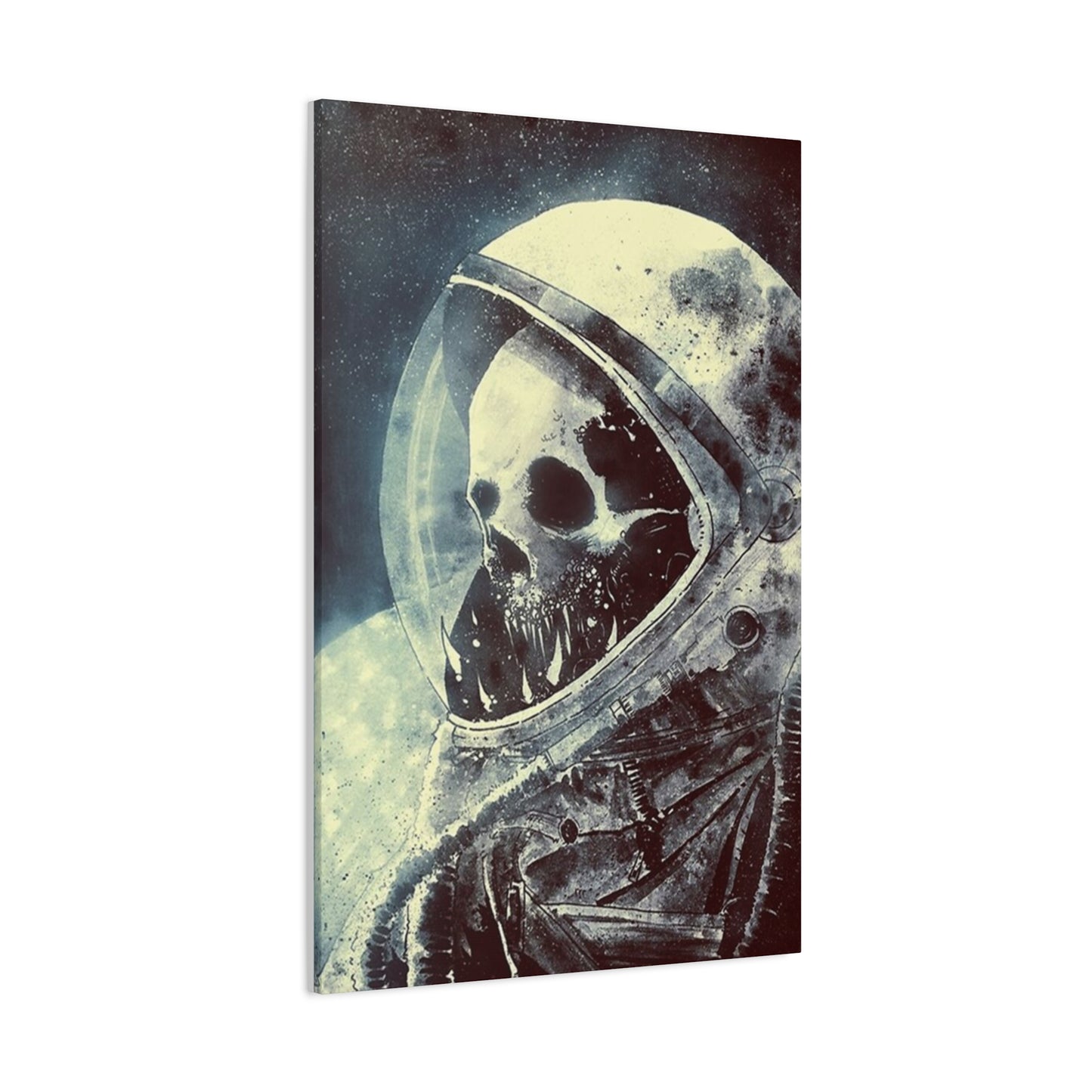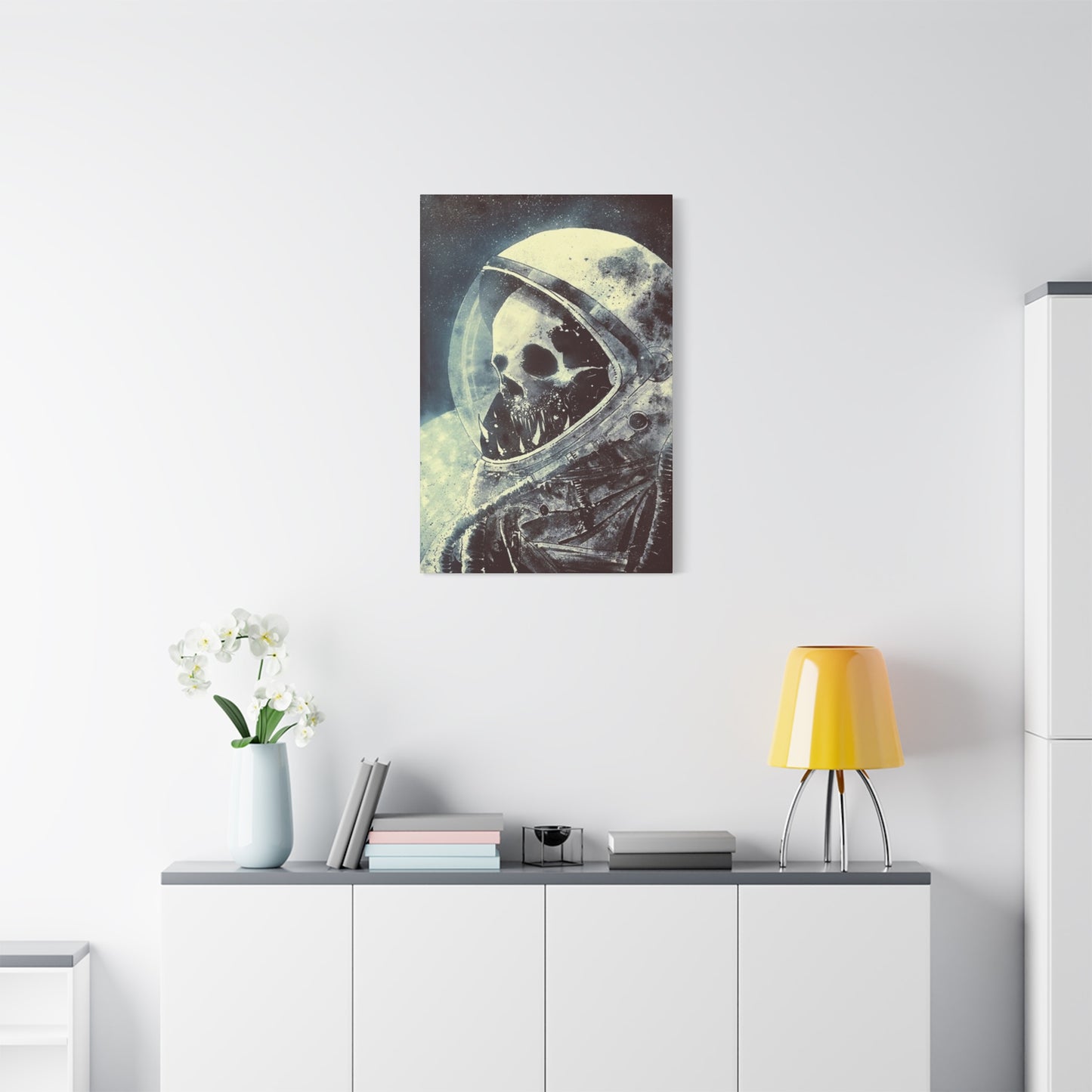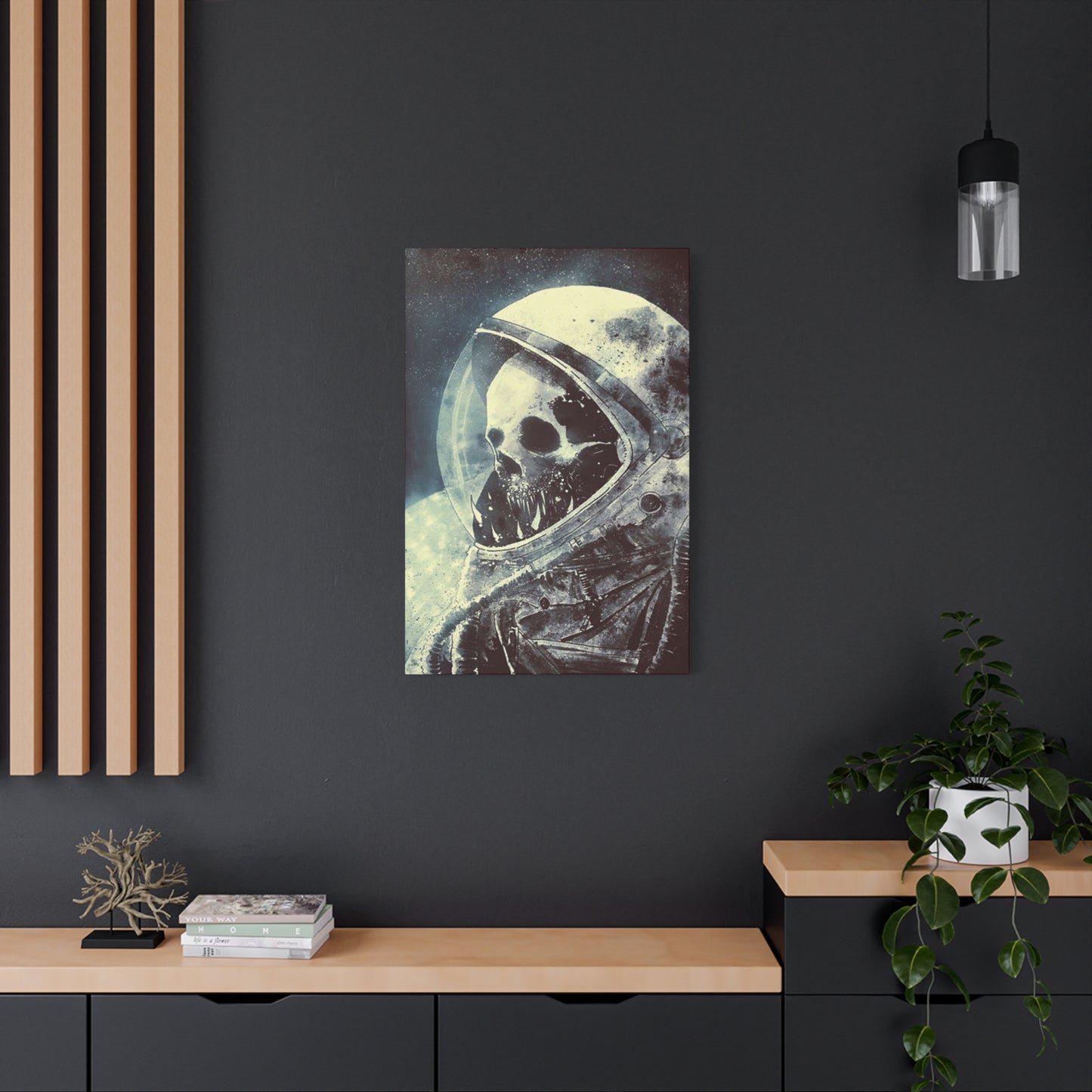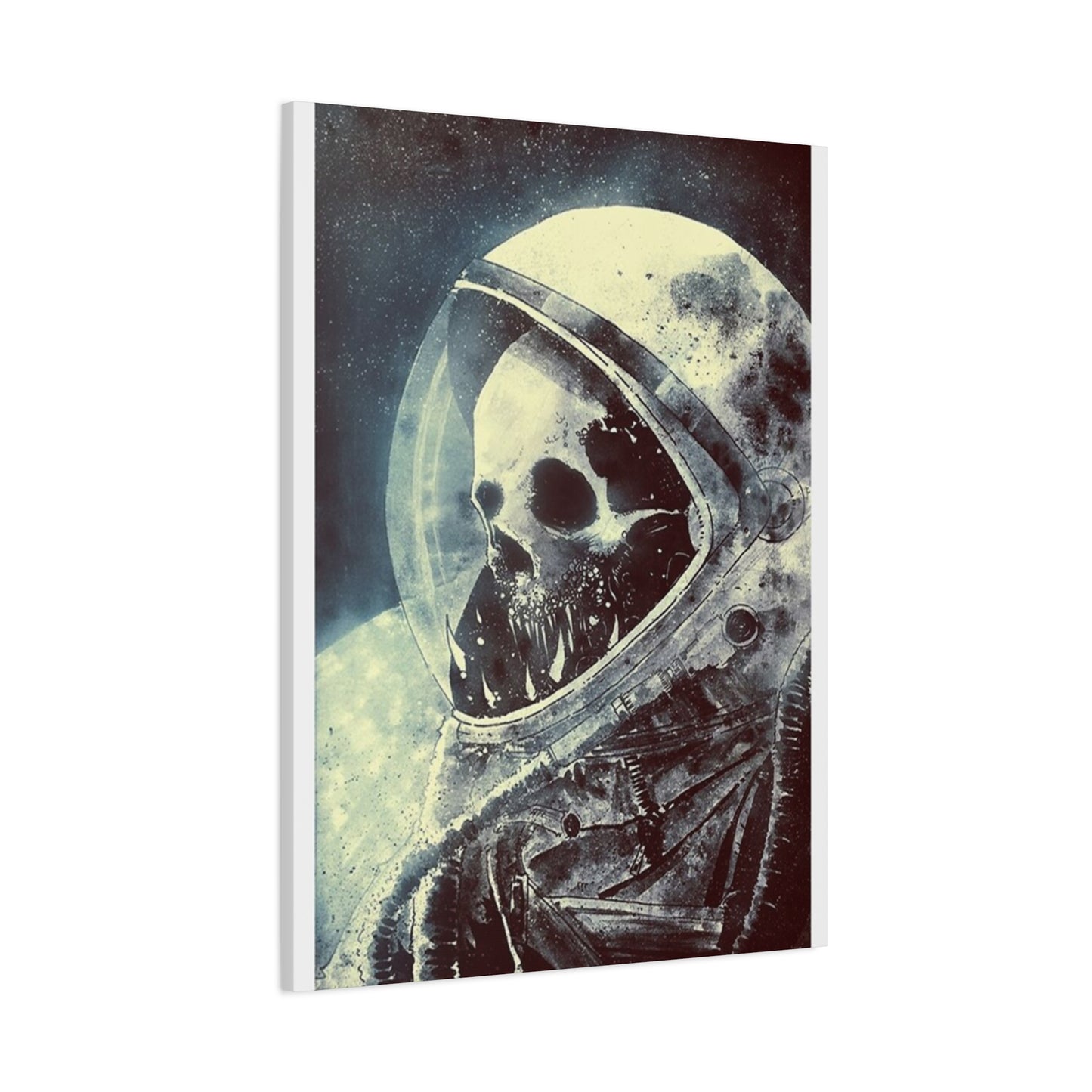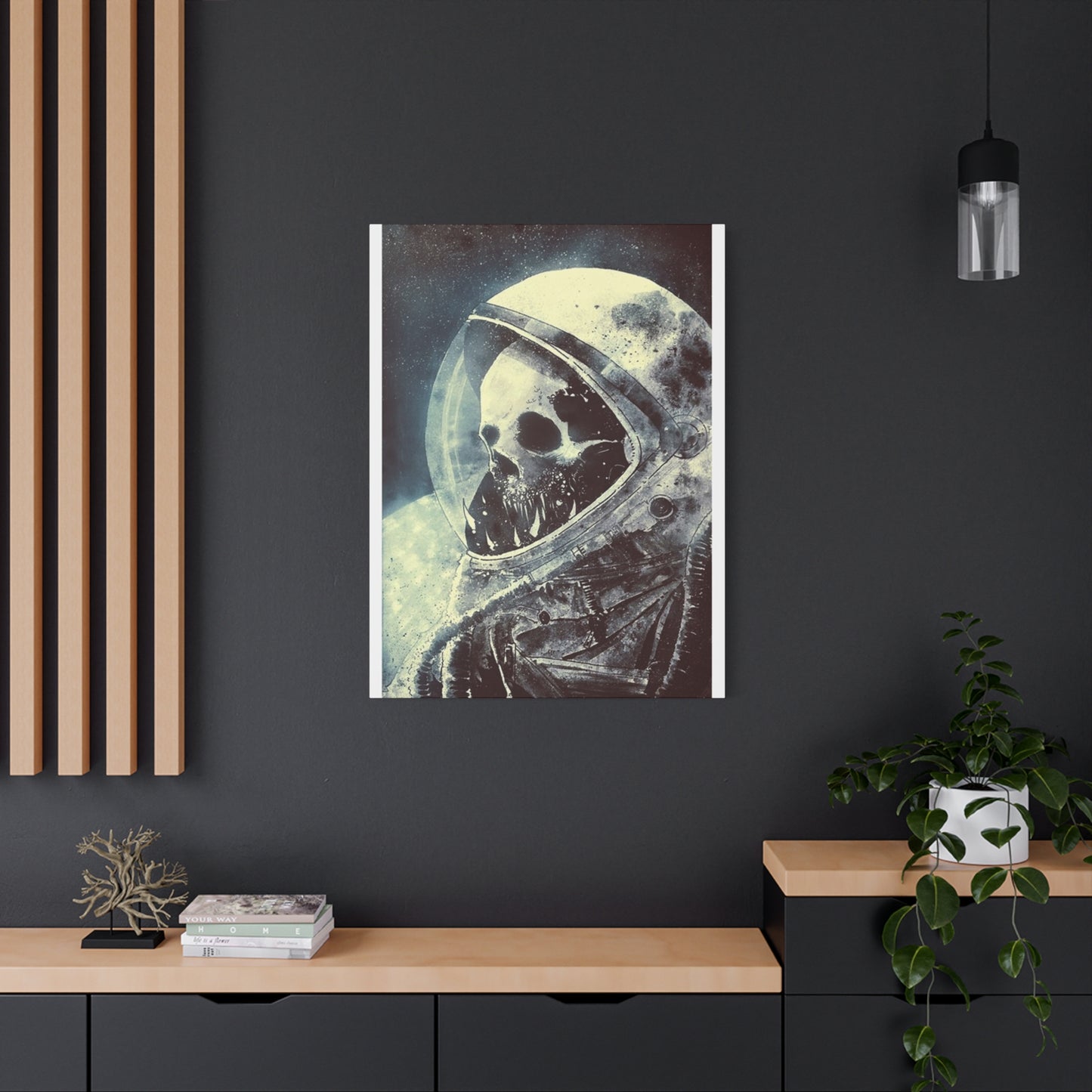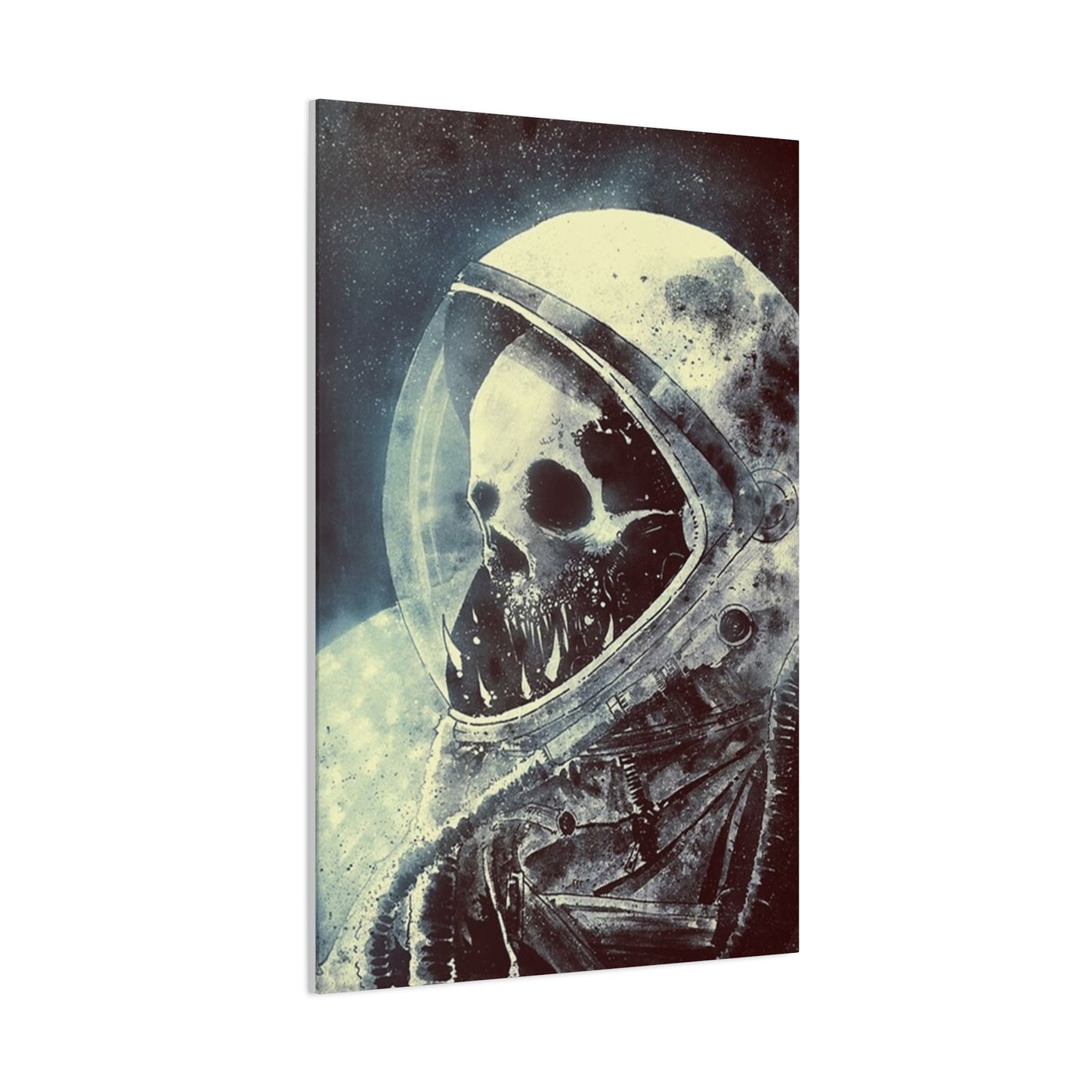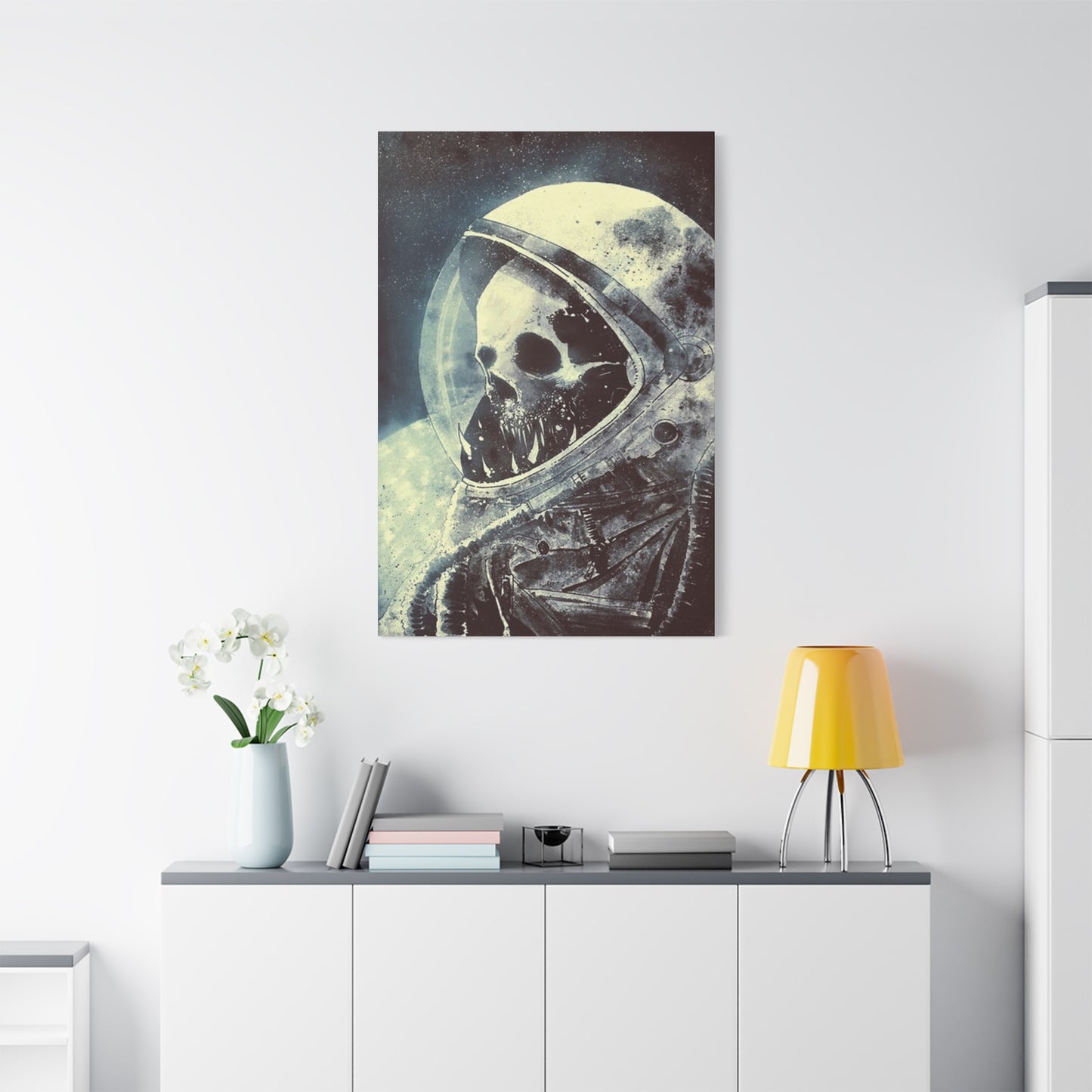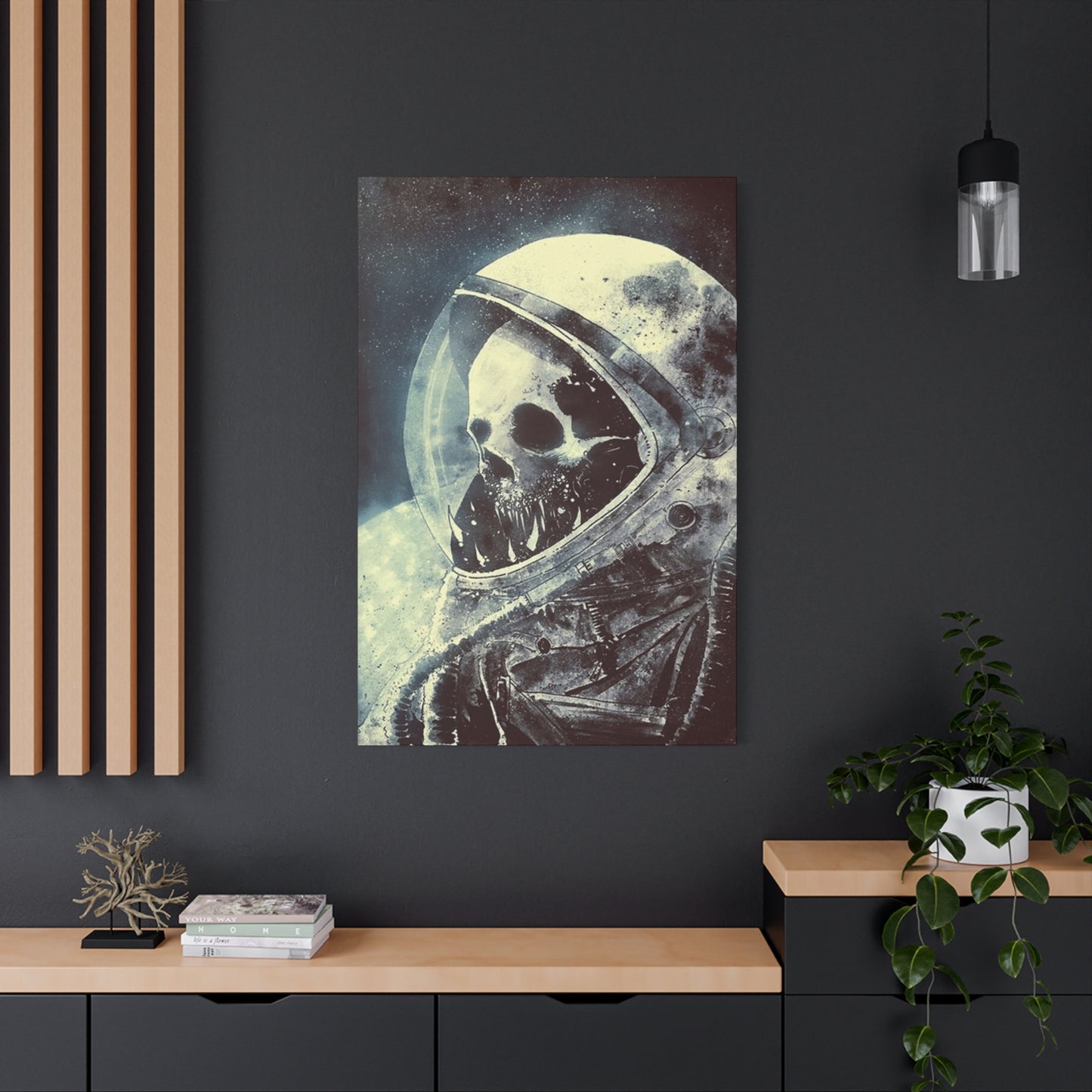Dark Cosmic Astronaut Skull Wall Art: Eye-Catching Home Decor
Skull wall art has emerged as one of the most captivating and provocative forms of contemporary home decoration, transcending traditional boundaries to become a powerful medium for artistic expression. This fascinating art form combines elements of mortality, beauty, rebellion, and cultural significance into striking visual displays that command attention and spark conversation. From ancient civilizations to modern galleries, skull imagery has maintained its position as a symbol that simultaneously represents death and life, fear and fascination, darkness and enlightenment.
The popularity of skull wall art in contemporary interior design reflects our society's evolving relationship with mortality and the macabre. No longer confined to gothic subcultures or Halloween decorations, skull art has found its place in mainstream design, appealing to individuals who seek to make bold statements in their living spaces. This artistic medium offers endless possibilities for creative expression, from hyper-realistic oil paintings to abstract interpretations, from minimalist line drawings to elaborate mixed-media installations.
The appeal of skull wall art extends beyond mere aesthetic considerations. For many collectors and enthusiasts, these pieces represent deeper philosophical concepts about the nature of existence, the beauty found in darkness, and the celebration of life's fleeting moments. The skull, as a universal symbol, speaks to fundamental human experiences that cross cultural and temporal boundaries, making it a versatile subject for artistic exploration.
Contemporary skull wall art encompasses an incredible diversity of styles, techniques, and interpretations. Artists working in this medium draw inspiration from various sources, including traditional Mexican Day of the Dead celebrations, gothic literature, punk rock aesthetics, medical illustrations, and ancient religious iconography. This rich tapestry of influences creates a vibrant and constantly evolving art form that continues to push creative boundaries.
The technical aspects of creating skull wall art have also evolved significantly with advances in digital technology and printing methods. Artists now have access to sophisticated tools that allow for unprecedented precision and creativity in their work. Digital manipulation, 3D modeling, and high-resolution printing have opened new avenues for artistic expression while traditional mediums like oil painting, watercolor, and charcoal continue to play important roles in the creation of skull art.
The psychological impact of skull wall art on viewers and living spaces cannot be understated. These pieces often serve as powerful conversation starters, creating focal points that draw the eye and engage the mind. The presence of skull art in a room can dramatically alter the atmosphere, introducing elements of mystery, sophistication, and edge that complement various interior design styles from industrial loft spaces to bohemian retreats.
Market trends in skull wall art reflect broader cultural movements toward personalization and self-expression in home decoration. Consumers increasingly seek unique pieces that reflect their individual personalities and values rather than mass-produced generic artwork. This demand has created opportunities for emerging artists to explore skull themes while establishing themselves in the competitive art market.
The therapeutic and meditative aspects of both creating and viewing skull art have gained recognition in recent years. Many artists report finding peace and clarity in the process of rendering these complex forms, while collectors describe a sense of contemplation and introspection when engaging with their skull art collections. This psychological dimension adds depth to the appreciation of skull wall art beyond its visual impact.
Street Art and Graffiti Inspired Skull Designs
Street art and graffiti have profoundly influenced contemporary skull wall art, bringing raw energy and urban authenticity to this ancient symbol. The marriage of skull imagery with street art aesthetics creates powerful visual statements that capture the rebellious spirit of urban culture while maintaining the profound symbolism associated with mortality themes. These artworks often feature bold color palettes, dynamic compositions, and techniques borrowed directly from the walls of cities around the world.
The evolution of street art skull designs can be traced back to the early days of hip-hop culture and urban graffiti movements. Artists working in these mediums recognized the skull as a potent symbol that could convey messages about social inequality, urban decay, violence, and resilience. The skull became a recurring motif in subway tunnels, abandoned buildings, and public walls, eventually transitioning from illegal expressions to legitimate gallery pieces and collectible wall art.
Contemporary street art-inspired skull wall art incorporates signature elements of graffiti culture, including bubble letters, wildstyle typography, aerosol paint effects, and layered compositions. Artists often combine photorealistic skull renderings with abstract geometric patterns, creating pieces that bridge the gap between representational and conceptual art. The use of stencils, a hallmark technique of street art, allows for precise reproduction of skull images while maintaining the rough, immediate quality associated with urban art forms.
Color plays a crucial role in street art skull designs, with artists frequently employing vibrant neons, metallic accents, and high-contrast combinations that make their work visible from great distances. These bold color choices translate effectively to wall art for interior spaces, creating focal points that energize rooms and reflect the dynamic nature of urban environments. The incorporation of dripping paint effects, splatter patterns, and weathered textures adds authentic street art character to these pieces.
The influence of specific graffiti artists and movements on skull wall art cannot be overlooked. Pioneering street artists who incorporated skull imagery into their work have inspired countless contemporary artists to explore similar themes. The democratization of street art through social media platforms has accelerated the spread of skull-themed graffiti styles, creating a global community of artists who share techniques and inspiration across cultural boundaries.
Technical innovations in street art have also impacted skull wall art creation. The development of specialized spray paints, markers, and stenciling materials has expanded the possibilities for artists working in this style. Digital tools now allow artists to plan complex layered compositions before executing them, resulting in more sophisticated and refined street art-inspired skull pieces suitable for indoor display.
The cultural significance of street art skull imagery extends beyond aesthetic considerations to encompass social and political commentary. Many artists use skull motifs to address issues such as urban violence, environmental degradation, and social injustice. These themes resonate strongly with contemporary audiences who appreciate art that engages with pressing societal concerns while maintaining visual impact.
Street art-inspired skull wall art has found particular popularity among younger demographics who identify with the rebellious and authentic nature of urban culture. This market segment appreciates the connection between their wall art and broader cultural movements, seeking pieces that reflect their values and lifestyle choices. The accessibility and relatability of street art aesthetics make skull wall art more approachable for viewers who might otherwise find traditional fine art intimidating or irrelevant.
The adaptation of street art techniques for indoor wall art has required artists to consider factors such as longevity, color fastness, and compatibility with interior environments. While maintaining the raw energy of street art, these pieces must meet quality standards appropriate for long-term display in homes and commercial spaces. This balance between authenticity and practicality has driven innovation in materials and techniques used for street art-inspired skull wall art.
Commercial applications of street art skull designs have expanded beyond individual collectors to include restaurants, nightclubs, retail spaces, and entertainment venues that seek to create edgy, contemporary atmospheres. The versatility of street art aesthetics allows for customization and scaling to suit various architectural contexts while maintaining visual impact and cultural relevance.
Day of the Dead Cultural Celebrations and Artistic Inspiration
Day of the Dead celebrations have provided rich source material for skull wall art, transforming traditional Mexican cultural imagery into contemporary artistic expressions that honor both cultural heritage and modern aesthetic sensibilities. This vibrant festival, known as Día de los Muertos, offers a unique perspective on death and remembrance that contrasts sharply with Western funeral traditions, presenting death as a natural part of life's cycle rather than something to be feared or avoided.
The artistic traditions associated with Day of the Dead have deep roots in pre-Columbian civilizations, particularly Aztec and Maya cultures that viewed death as a transition rather than an ending. These ancient perspectives on mortality continue to influence contemporary skull wall art, providing artists with a framework for exploring themes of memory, celebration, and spiritual continuity. The incorporation of indigenous artistic elements creates pieces that are both visually striking and culturally meaningful.
Sugar skulls, or calaveras de azúcar, represent perhaps the most recognizable element of Day of the Dead imagery adapted for wall art. These decorative skulls, traditionally made from sugar and ornately decorated, translate beautifully to two-dimensional artistic representations. Contemporary artists have expanded upon traditional sugar skull designs, incorporating modern color palettes, abstract patterns, and innovative compositional approaches while maintaining the celebratory spirit of the original cultural practice.
The color symbolism inherent in Day of the Dead celebrations provides rich material for skull wall art creation. Traditional colors such as deep oranges, vibrant magentas, brilliant yellows, and rich purples carry specific cultural meanings related to life, death, and spiritual energy. Contemporary artists working with Day of the Dead themes often expand these traditional palettes while maintaining the essential vibrancy and emotional resonance associated with the celebration.
Floral motifs play a significant role in Day of the Dead skull art, with marigolds, roses, and other flowers representing the beauty and fragility of life. These botanical elements are often integrated into skull compositions, creating pieces that balance the starkness of bone imagery with the softness and color of living plants. The juxtaposition of death symbols with life-affirming floral designs creates powerful visual metaphors that resonate with viewers on multiple levels.
The evolution of Day of the Dead skull art has been influenced by contemporary art movements and global cultural exchange. While maintaining respect for traditional cultural elements, modern artists have incorporated techniques from various artistic traditions, creating hybrid works that speak to both Mexican heritage and international art audiences. This cultural fusion has resulted in innovative approaches to skull imagery that expand the possibilities for artistic expression.
Portrait elements often appear in Day of the Dead inspired skull wall art, with artists incorporating photographic elements or realistic facial features into decorative skull designs. These portrait skulls serve as memorials or celebrations of specific individuals, transforming the anonymous skull symbol into personalized tributes that honor particular lives and relationships. This personalization aspect has made Day of the Dead skull art particularly appealing for commemorative purposes.
The influence of contemporary Mexican artists on skull wall art cannot be overstated. Artists such as José Guadalupe Posada, whose iconic La Catrina figure has become synonymous with Day of the Dead imagery, continue to inspire contemporary creators. Modern Mexican artists working in various mediums have expanded upon these traditional foundations, creating innovative skull art that bridges historical and contemporary perspectives.
Commercial production of Day of the Dead inspired skull wall art has grown significantly in recent years, driven by increased cultural awareness and appreciation for Mexican traditions. This commercial success has provided economic opportunities for artists while also raising questions about cultural appropriation and the commercialization of sacred traditions. Responsible artists and manufacturers strive to honor the cultural significance of Day of the Dead imagery while creating accessible art for global audiences.
The therapeutic and spiritual aspects of Day of the Dead skull art have gained recognition beyond their cultural origins. Many individuals find comfort in the celebration of life and acceptance of death represented in these artworks. The positive approach to mortality embodied in Day of the Dead traditions offers an alternative to Western anxiety about death, providing healing and perspective for viewers dealing with loss or existential concerns.
Educational applications of Day of the Dead skull wall art have expanded as cultural awareness programs seek to promote understanding of Mexican traditions. Schools, cultural centers, and museums use these artworks to teach about cultural diversity, historical traditions, and artistic techniques. This educational dimension adds value to Day of the Dead skull art beyond its aesthetic and commercial appeal.
Three-Dimensional and Digital Skull Art Innovations
Three-dimensional and digital skull wall art represents the cutting edge of contemporary artistic expression, combining traditional skull imagery with advanced technology and innovative materials to create immersive visual experiences. This evolution in skull art reflects broader trends in contemporary art toward multimedia approaches and technological integration, resulting in pieces that challenge traditional boundaries between sculpture, painting, and digital media.
The development of 3D skull wall art has been facilitated by advances in materials science and manufacturing technology. Modern sculptors working with skull themes have access to lightweight composites, advanced ceramics, and synthetic materials that allow for intricate detail while maintaining structural integrity suitable for wall mounting. These technical capabilities have enabled artists to create skull sculptures that appear to emerge from walls or float in space, creating dramatic visual effects that enhance interior spaces.
Digital art techniques have revolutionized the creation and reproduction of skull wall art, allowing artists to achieve levels of detail and complexity previously impossible with traditional mediums. Computer graphics software enables precise manipulation of skull imagery, from photorealistic medical illustrations to fantastical interpretations that blend anatomical accuracy with imaginative elements. The ability to work in virtual three-dimensional space allows digital artists to explore skull forms from multiple perspectives and lighting conditions.
Augmented reality applications have begun to influence skull wall art, with some pieces incorporating digital elements that can be accessed through smartphone apps or specialized viewing devices. These hybrid artworks combine physical prints or sculptures with digital overlays that provide additional layers of visual information or interactive elements. This integration of physical and digital realms creates viewing experiences that evolve and change based on technological interaction.
The precision possible with digital tools has enabled the creation of highly detailed anatomical skull art that serves both artistic and educational purposes. Medical illustration techniques applied to skull wall art result in pieces that are scientifically accurate while maintaining aesthetic appeal. These works appeal to audiences interested in both art and science, creating crossover appeal that expands the market for skull-themed artwork.
Three-dimensional printing technology has democratized the creation of sculptural skull wall art, allowing artists and consumers to produce custom pieces with unprecedented ease and affordability. Digital skull models can be modified, scaled, and reproduced using 3D printing technology, creating opportunities for mass customization and personalized artwork. This accessibility has contributed to the growth of skull art collecting among younger demographics comfortable with digital technology.
Lighting integration has become a significant aspect of three-dimensional skull wall art, with artists incorporating LED systems, fiber optics, and other illumination technologies to enhance their pieces. These lighting elements can create dramatic shadows, highlight specific features, or provide color-changing effects that transform the artwork throughout different viewing periods. The dynamic nature of illuminated skull art adds temporal dimensions to static pieces.
Digital manipulation techniques have expanded the creative possibilities for skull wall art by allowing artists to combine photographic elements, painted textures, and computer-generated imagery into cohesive compositions. These hybrid approaches result in artworks that would be impossible to create using traditional methods alone, opening new avenues for artistic expression and visual impact.
The environmental considerations associated with digital skull art production have become increasingly important as sustainability concerns influence artistic practice. Digital creation and reproduction methods can reduce material waste compared to traditional art production, while also eliminating the need for potentially hazardous chemicals used in conventional art materials. This environmental advantage appeals to environmentally conscious consumers and artists.
Virtual reality technologies are beginning to influence skull wall art through the creation of immersive environments where viewers can interact with three-dimensional skull imagery in virtual spaces. While still in early stages, these applications suggest future possibilities for skull art that transcends physical limitations and creates entirely new categories of artistic experience.
Quality control and archival considerations for digital skull wall art require careful attention to printing methods, material selection, and environmental factors that affect longevity. Unlike traditional art mediums with established preservation practices, digital art presents new challenges for collectors and institutions concerned with maintaining artwork quality over time. Research into best practices for digital art preservation continues to evolve as the medium matures.
Cultural Symbolism and Historical Context of Skull Imagery
The cultural symbolism behind skull art encompasses thousands of years of human civilization, representing one of the most universal and enduring symbols in artistic expression. Skulls have appeared in art across virtually every culture and historical period, carrying meanings that range from warnings about mortality to celebrations of life, from religious devotion to rebellious defiance. Understanding these deep cultural roots enhances appreciation for contemporary skull wall art and provides context for its continued relevance in modern society.
Ancient civilizations incorporated skull imagery into their artistic and religious practices, establishing symbolic associations that continue to influence contemporary interpretations. Egyptian art featured skulls in funerary contexts, representing the journey between life and afterlife, while Greek and Roman cultures used skull motifs to remind viewers of life's transience through the memento mori tradition. These classical influences established skull imagery as a serious artistic subject worthy of contemplation and respect.
Medieval European art extensively utilized skull symbolism in religious contexts, particularly in vanitas paintings that reminded viewers of earthly life's temporary nature. These works often combined skull imagery with other symbols of mortality such as wilting flowers, extinguished candles, and timepieces, creating complex allegorical compositions that encouraged spiritual reflection. The sophistication of medieval skull symbolism demonstrates the depth of meaning possible within this artistic tradition.
Renaissance artists elevated skull imagery to new heights of technical and symbolic sophistication, incorporating anatomical accuracy gained through scientific study with traditional symbolic meanings. Artists such as Leonardo da Vinci and Albrecht Dürer created skull studies that were simultaneously scientific documents and artistic masterpieces, establishing precedents for the combination of accuracy and artistry that characterizes much contemporary skull wall art.
Indigenous cultures worldwide have developed unique approaches to skull symbolism that differ significantly from European traditions. Native American, African, and Asian cultures often view skulls as protective spirits or ancestral guides rather than symbols of death and decay. These alternative interpretations provide contemporary artists with rich source material for creating skull art that celebrates life and spiritual continuity rather than focusing solely on mortality themes.
The Gothic revival movement of the 18th and 19th centuries renewed interest in skull imagery, particularly in literature and decorative arts. This period saw the development of romantic interpretations of skull symbolism that emphasized mystery, emotion, and individual expression over religious or philosophical messaging. The Gothic influence on skull art established foundations for contemporary interpretations that prioritize aesthetic impact and personal meaning over traditional symbolic frameworks.
Modern psychological interpretations of skull symbolism have added new layers of meaning to contemporary skull wall art. Jungian analysis suggests that skull imagery represents archetypal symbols residing in the collective unconscious, explaining their universal appeal and emotional impact. These psychological perspectives provide artists and collectors with frameworks for understanding their attraction to skull imagery beyond surface aesthetic considerations.
The appropriation and recontextualization of skull symbols by various subcultures have created new meanings and associations that influence contemporary skull wall art. Punk rock, heavy metal, and gothic subcultures have embraced skull imagery as symbols of rebellion against mainstream society, while biker culture has adopted skulls as markers of toughness and nonconformity. These subcultural associations add layers of social meaning to skull art that resonate with specific audience segments.
Contemporary globalization has facilitated cross-cultural exchange of skull symbolism, resulting in hybrid interpretations that combine elements from multiple traditions. Artists working today have access to symbolic vocabularies from around the world, creating opportunities for innovative combinations and reinterpretations that speak to increasingly diverse audiences. This cultural fusion enriches the possibilities for skull wall art while raising questions about cultural appropriation and respectful representation.
The commercialization of skull imagery in popular culture has both democratized access to skull art and potentially diluted its symbolic power. Mass production of skull-themed merchandise has made skull imagery ubiquitous in contemporary society, potentially reducing its impact and meaning for some audiences while simultaneously introducing it to new viewers who might not otherwise encounter such symbolism.
Academic study of skull symbolism continues to reveal new interpretations and historical contexts that inform contemporary artistic practice. Art historians, anthropologists, and cultural critics contribute ongoing research that deepens understanding of skull imagery's role in human culture, providing contemporary artists with scholarly foundations for their creative work.
The digital age has created new contexts for skull symbolism, with internet culture developing its own interpretations and applications of skull imagery. Emoji, memes, and digital art have created contemporary skull symbols that carry different meanings from traditional interpretations, reflecting changing attitudes toward mortality, technology, and communication in the 21st century.
Surrealist Movement and Skull Imagery in Contemporary Art
Surrealist painting techniques have profoundly influenced contemporary skull wall art, introducing dreamlike qualities and psychological depth that transform traditional mortality themes into explorations of the unconscious mind and alternate realities. The surrealist movement's emphasis on automatic drawing, dream imagery, and psychological symbolism provides rich inspiration for artists creating skull art that transcends literal representation to explore deeper aspects of human experience and imagination.
The historical relationship between surrealism and skull imagery can be traced to the movement's fascination with death, transformation, and the unconscious mind. Pioneer surrealist artists such as Salvador Dalí incorporated skull motifs into their work as symbols of psychological states and dream imagery rather than simple memento mori reminders. This psychological approach to skull symbolism opened new avenues for artistic interpretation that continue to influence contemporary skull wall art.
Contemporary surrealist skull art often employs techniques of morphing and transformation, showing skulls in various states of decay, reconstruction, or metamorphosis into other forms. These transformation sequences create visual narratives that explore themes of change, growth, and the fluid nature of identity and existence. The dynamic quality of surrealist skull imagery contrasts sharply with static traditional representations, creating more engaging and psychologically complex artworks.
Dream logic plays a significant role in surrealist skull wall art, with artists creating compositions that follow emotional and symbolic relationships rather than literal or logical connections. Skulls might appear floating in impossible landscapes, growing flowers from eye sockets, or morphing into architectural structures, creating scenes that capture the illogical yet emotionally coherent nature of dream experiences.
The technique of automatic drawing, central to surrealist practice, has been adapted for digital skull art creation, with artists using random generation algorithms and chance operations to create unexpected skull imagery. These automatic processes can produce surprising combinations and forms that might not occur through conscious artistic planning, resulting in skull art that captures the spontaneous and unconscious qualities valued by surrealist artists.
Psychological symbolism in surrealist skull art often addresses themes of identity, memory, and personal transformation rather than universal mortality concepts. Individual skulls might be portrayed with personal objects, childhood memories, or emotional landscapes integrated into their forms, creating highly personalized artworks that speak to specific psychological experiences while maintaining broader symbolic appeal.
The influence of Freudian psychoanalysis on surrealist skull art introduces sexual and repressive themes that add complexity to traditional skull imagery. These psychological layers create artwork that operates on multiple levels of meaning, appealing to viewers' conscious aesthetic appreciation while engaging with deeper unconscious psychological processes.
Contemporary digital tools have expanded the possibilities for creating surrealist skull art, allowing artists to achieve effects and combinations that would be extremely difficult or impossible using traditional painting techniques. Digital manipulation, layering, and morphing capabilities enable the creation of complex surrealist compositions that maintain the movement's core principles while utilizing 21st-century technology.
The therapeutic applications of creating and viewing surrealist skull art have gained recognition in art therapy contexts, where the symbolic and emotional content of these works can facilitate exploration of psychological issues and personal growth. The non-literal nature of surrealist imagery allows for safe exploration of difficult topics while maintaining aesthetic distance from literal representations.
Commercial applications of surrealist skull wall art have found success in contemporary interior design contexts where clients seek artwork that serves as conversation starters and psychological focal points. The mysterious and thought-provoking nature of surrealist skull imagery makes these pieces particularly effective for creating atmospheric interior spaces that encourage contemplation and discussion.
The relationship between surrealist skull art and contemporary popular culture includes influences from fantasy art, science fiction, and horror genres that share surrealism's interest in alternate realities and psychological exploration. These cross-influences create hybrid artistic approaches that appeal to diverse audiences while maintaining surrealist core principles of psychological exploration and visual surprise.
Educational applications of surrealist skull art include its use in psychology and art history courses as examples of how artistic movements engage with contemporary intellectual and cultural developments. The connection between surrealist techniques and psychological theories provides rich material for interdisciplinary study that enhances understanding of both artistic and psychological principles.
Skull Portraits as Personal Statement Art
Skull portraits represent a unique category of wall art that combines the universal symbolism of mortality with individual identity, creating powerful personal statements that reflect the subject's character, values, and life experience. These artworks transcend traditional portraiture by replacing or incorporating facial features with skull imagery, resulting in pieces that simultaneously celebrate and memorialize human individuality while acknowledging shared mortality.
The conceptual foundation of skull portraiture rests on the paradox of representing individual identity through universal symbols of death. Artists working in this medium must balance the recognizable aspects of human portraiture with the abstract symbolism of skull imagery, creating compositions that maintain personal connection while engaging with broader themes of existence and meaning. This balance requires sophisticated artistic techniques and deep understanding of both portrait conventions and symbolic representation.
Technical approaches to skull portrait creation vary widely, from photorealistic paintings that seamlessly blend facial features with anatomical skull details to abstract interpretations that suggest rather than literally depict the integration of life and death imagery. Digital manipulation techniques allow artists to overlay skull imagery onto photographic portraits, creating hybrid images that maintain photographic detail while introducing symbolic elements.
The emotional impact of skull portraits on viewers and subjects involves complex psychological responses to the combination of familiar and unsettling imagery. These pieces can serve as memorials for deceased individuals, philosophical statements about mortality, or artistic explorations of identity and self-perception. The personal nature of portraiture combined with skull symbolism creates artwork that operates on intimate and universal levels simultaneously.
Cultural considerations in skull portraiture require sensitivity to different traditions and beliefs about death, identity, and artistic representation. While some cultures embrace direct engagement with mortality themes, others may find skull portraiture disturbing or inappropriate. Contemporary artists must navigate these cultural differences while maintaining artistic integrity and respecting diverse viewpoints about death and representation.
The market for skull portrait wall art has grown among collectors seeking highly personalized artwork that reflects their individual aesthetic preferences and philosophical perspectives. Custom skull portraits, created from personal photographs or specifications, provide unique alternatives to traditional portraiture while making bold statements about the client's personality and values. This market segment values both artistic quality and personal significance in their art acquisitions.
Celebrity and public figure skull portraits have become popular subjects for contemporary artists, creating commentary on fame, mortality, and cultural significance. These works often combine recognizable facial features with decorative skull elements, creating pieces that simultaneously celebrate and critique celebrity culture while engaging with themes of lasting legacy and temporary fame.
The psychology of commissioning or collecting skull portraits reveals interesting insights into contemporary attitudes toward death, identity, and artistic expression. Individuals drawn to skull portraiture often express desires for artwork that acknowledges life's complexity and temporary nature while celebrating personal significance and individual character. These motivations reflect broader cultural shifts toward more direct engagement with mortality themes.
Educational applications of skull portraiture include art therapy contexts where clients explore issues of identity, mortality, and self-perception through creative expression. The symbolic nature of skull imagery allows for exploration of difficult emotional territory while maintaining artistic distance from literal self-representation. These therapeutic applications demonstrate the healing potential of engaging with skull imagery in personal contexts.
Installation and display considerations for skull portraits require attention to lighting, positioning, and contextual elements that enhance their emotional and visual impact. These pieces often serve as focal points for interior spaces, demanding prominent placement and appropriate lighting to maximize their dramatic effect. The personal nature of skull portraits also influences display decisions, with many collectors choosing private spaces for more intimate viewing experiences.
The evolution of skull portraiture techniques continues as artists experiment with new materials, digital technologies, and conceptual approaches. Contemporary practitioners are developing innovative methods for combining portrait and skull imagery, from mixed media approaches that incorporate actual bone fragments to augmented reality applications that allow viewers to interact with digital skull elements overlaying traditional portraits.
Ethical considerations in skull portraiture include questions about consent, representation, and the appropriate use of deceased individuals' likenesses in artistic contexts. Artists creating skull portraits must consider the wishes of subjects and their families while maintaining artistic freedom and expression. These ethical questions become particularly complex when dealing with historical figures or public personalities whose images exist in the public domain.
Dark Aesthetic and Gothic Influences in Modern Skull Art
Dark aesthetic skull canvases represent a sophisticated artistic movement that draws inspiration from gothic literature, romantic period art, and contemporary alternative culture to create visually striking pieces that celebrate beauty found in darkness and shadow. This artistic approach transforms traditional skull imagery through dramatic lighting, rich color palettes, and atmospheric compositions that evoke mystery, elegance, and psychological depth rather than simple macabre shock value.
The historical foundations of dark aesthetic art can be traced to the Gothic Revival movement of the 18th and 19th centuries, which romanticized medieval architecture, literature, and artistic themes. This cultural movement established precedents for finding beauty in darkness, celebrating emotional intensity, and exploring themes of mortality and transcendence through artistic expression. Contemporary dark aesthetic skull art continues these traditions while incorporating modern techniques and sensibilities.
Lighting techniques play a crucial role in dark aesthetic skull canvases, with artists employing dramatic chiaroscuro effects, selective illumination, and atmospheric shadows to create mood and visual impact. These lighting approaches draw inspiration from baroque painting traditions while utilizing contemporary understanding of color theory and psychological responses to different lighting conditions. The result is artwork that commands attention and creates emotional responses through sophisticated manipulation of light and shadow.
Color palette selection in dark aesthetic skull art typically emphasizes deep, rich tones such as burgundy, midnight blue, forest green, and charcoal black, often accented with metallic highlights or jewel tones that add sophistication and depth. These color choices create visual richness that rewards close examination while maintaining overall atmospheric unity. The sophisticated use of color distinguishes dark aesthetic skull art from simpler gothic or horror imagery.
Texture and surface treatment contribute significantly to the appeal of dark aesthetic skull canvases, with artists employing various techniques to create visual and tactile interest. Heavy impasto, glazing techniques, mixed media applications, and digital texture overlays add depth and complexity to skull imagery, creating pieces that engage viewers on multiple sensory levels. These textural elements enhance the psychological impact of dark aesthetic compositions.
Contemporary goth and alternative culture influences have shaped dark aesthetic skull art by providing contemporary contexts for traditional gothic themes. Music, fashion, and lifestyle elements from these subcultures inform artistic choices in color, composition, and symbolic content, creating artwork that resonates with contemporary audiences while maintaining connections to historical gothic traditions.
The integration of feminine elements into dark aesthetic skull art has created a subgenre that challenges traditional associations between skulls and masculine imagery. Artists incorporate flowers, lace patterns, jewelry, and other traditionally feminine motifs into skull compositions, creating pieces that explore gender, beauty, and mortality through alternative symbolic frameworks. This integration expands the appeal and meaning of skull art for diverse audiences.
Architectural elements frequently appear in dark aesthetic skull compositions, with artists incorporating gothic arches, ornate stonework, stained glass patterns, and other structural elements that enhance the atmospheric quality of their work. These architectural references connect skull imagery to broader cultural and historical contexts while adding compositional interest and symbolic depth.
The psychological appeal of dark aesthetic skull art relates to contemporary fascination with alternative beauty standards and the recognition that darkness and light exist in constant relationship with each other. Viewers attracted to dark aesthetic art often appreciate the emotional complexity and intellectual sophistication possible within gothic artistic traditions, seeking artwork that reflects their personal aesthetic preferences and philosophical perspectives.
Commercial applications of dark aesthetic skull canvases have found success in interior design contexts ranging from residential to commercial spaces. Restaurants, hotels, retail stores, and entertainment venues utilize dark aesthetic skull art to create atmospheric environments that appeal to clientele seeking sophisticated alternatives to mainstream decorative art. The versatility of dark aesthetic approaches allows for adaptation to various architectural and design contexts.
Production techniques for dark aesthetic skull wall art have evolved to include both traditional painting methods and contemporary digital approaches. Artists may combine oil painting techniques with digital enhancement, or create entirely digital compositions that mimic traditional artistic effects. These technical choices allow artists to achieve specific aesthetic goals while working within practical constraints of time, budget, and client requirements.
The influence of contemporary horror and fantasy media on dark aesthetic skull art creates cross-cultural references that enhance the relevance and appeal of these works for modern audiences. Films, literature, video games, and other media provide visual and thematic inspiration that artists incorporate into their skull compositions, creating pieces that speak to contemporary cultural experiences while maintaining artistic integrity.
Mixed Media Innovation in Contemporary Skull Art
Mixed media approaches to skull art represent the cutting edge of contemporary artistic expression, combining traditional art materials with unconventional elements to create multi-dimensional pieces that engage viewers on multiple sensory and intellectual levels. This innovative approach reflects broader trends in contemporary art toward breaking down boundaries between different artistic mediums and creating immersive experiences that transcend traditional categorizations of painting, sculpture, and digital art.
The conceptual foundations of mixed media skull art rest on the principle that different materials and techniques can contribute unique qualities to artistic expression that would be impossible to achieve using single mediums alone. Artists working in this area carefully select combinations of materials based on their symbolic significance, visual properties, and ability to contribute to the overall impact of the piece. This thoughtful approach to material selection elevates mixed media skull art beyond mere novelty to serious artistic expression.
Traditional art materials form the foundation for most mixed media skull artworks, with oil paints, acrylics, charcoal, and pencil providing base imagery that is then enhanced or modified through additional elements. The skill required to effectively combine these traditional materials with unconventional elements demands high levels of technical competency and artistic vision, resulting in pieces that demonstrate mastery of multiple artistic techniques simultaneously.
Three-dimensional elements frequently appear in mixed media skull art, ranging from actual bone fragments and medical specimens to sculpted clay additions and found objects that relate thematically to mortality and existence. These dimensional elements create physical presence that extends beyond the flat picture plane, transforming wall-mounted artwork into sculptural installations that cast shadows and create changing visual experiences as lighting conditions vary.
Digital integration has become increasingly important in mixed media skull art, with artists incorporating printed photographs, digital manipulations, and even video elements into their compositions. These technological additions allow for effects and imagery that would be impossible to achieve using traditional methods alone, while also reflecting contemporary culture's integration of digital and physical realities.
Textile elements bring softness and tactile interest to mixed media skull compositions, with artists incorporating fabric, lace, leather, and other materials that provide textural contrast to hard skull imagery. These soft elements often carry symbolic significance related to life, comfort, and human experience, creating emotional balance within compositions that might otherwise feel cold or intimidating.
Found object incorporation allows artists to include elements with personal or cultural significance that add layers of meaning to their skull compositions. Vintage jewelry, antique keys, dried flowers, and other discovered objects bring history and narrative elements that enhance the storytelling aspects of mixed media skull art. The selection and placement of these objects require careful consideration of their symbolic and aesthetic contributions to the overall piece.
Lighting integration has become a sophisticated aspect of mixed media skull art, with artists incorporating LED strips, fiber optics, and other illumination technologies that transform their pieces throughout different viewing periods. These lighting elements can highlight specific features, create atmospheric effects, or provide color changes that add temporal dimensions to static artworks.
Conservation considerations for mixed media skull art present unique challenges due to the variety of materials involved and their potentially different aging and deterioration characteristics. Artists and collectors must consider long-term stability, environmental sensitivity, and maintenance requirements when creating or acquiring mixed media pieces. These practical concerns influence artistic choices and affect market values for mixed media skull art.
The environmental impact of mixed media skull art has become an increasingly important consideration as artists and collectors become more conscious of sustainability issues. Some artists have embraced recycling and upcycling approaches, incorporating discarded materials into their skull compositions as both environmental statements and artistic challenges. These environmentally conscious approaches add additional layers of meaning to mixed media skull art.
Educational applications of mixed media skull art techniques provide rich material for art instruction, demonstrating how different materials and techniques can be combined to achieve specific artistic goals. Students working with mixed media approaches develop problem-solving skills, material knowledge, and creative flexibility that serve them well in various artistic contexts beyond skull imagery.
Market reception of mixed media skull art varies depending on the specific materials used, artistic quality, and conceptual sophistication of individual pieces. Collectors particularly value works that demonstrate innovative use of materials combined with high levels of artistic skill and meaningful conceptual content. The uniqueness inherent in mixed media approaches also appeals to collectors seeking one-of-a-kind pieces that cannot be easily reproduced.
Contemporary Illustration Techniques in Skull Art
Contemporary skull illustrations have evolved far beyond traditional anatomical drawings to encompass a wide range of artistic styles, techniques, and interpretative approaches that reflect current trends in digital art, graphic design, and visual communication. This evolution has been driven by advances in digital technology, changing aesthetic preferences, and the increasing integration of illustration into commercial and fine art contexts.
Digital illustration tools have revolutionized the creation of skull art by providing artists with unprecedented control over line quality, color application, and compositional elements. Software applications designed specifically for illustration work offer specialized brushes, texture libraries, and effect filters that enable artists to achieve specific aesthetic goals efficiently and precisely. These tools have democratized high-quality illustration creation while expanding the creative possibilities available to skull artists.
Conclusion
Dark Cosmic Astronaut Skull Wall Art is a bold and imaginative fusion of science fiction, surrealism, and contemporary décor, making it an eye-catching addition to any interior. These artworks combine the mystery of outer space with the intrigue of the macabre, creating a striking visual narrative that captivates and challenges viewers. The imagery of an astronaut’s skull floating through cosmic landscapes evokes a sense of adventure, mortality, and the infinite unknown, blending edgy aesthetics with thought-provoking symbolism. This wall art appeals to lovers of science fiction, dark art, and modern design, offering a unique way to express personality and style within a space.
Incorporating dark cosmic astronaut skull art into interiors allows homeowners and designers to create spaces that are both dramatic and visually stimulating. In living rooms, bedrooms, or entertainment areas, these pieces serve as bold focal points that spark conversation and draw attention. In studios or creative workspaces, they inspire imagination and curiosity, offering a reminder of exploration and the vastness of the universe. The contemporary, surrealist style of this artwork ensures it complements modern, industrial, or eclectic décor, adding a sense of mystery and intrigue while maintaining visual sophistication.
The artistic craftsmanship behind dark cosmic astronaut skull wall art emphasizes intricate detail, color contrasts, and atmospheric depth. Artists skillfully blend elements of space, texture, and surreal imagery to convey a sense of movement and narrative within the piece. The interplay of light, shadow, and cosmic motifs creates a three-dimensional effect that makes the artwork immersive and engaging. Each detail—from the contours of the skull to the swirling galaxies—adds layers of meaning, transforming the wall art from mere decoration into a statement piece that invites contemplation.
Ultimately, Dark Cosmic Astronaut Skull Wall Art elevates interior spaces by merging imaginative storytelling with striking visual impact. It transforms walls into portals of creativity, mystery, and expression, offering both aesthetic appeal and conceptual depth. By incorporating this artwork, individuals can showcase their unique style, inspire curiosity, and create interiors that are bold, memorable, and deeply engaging—making it a timeless and dramatic addition to modern home décor.


















